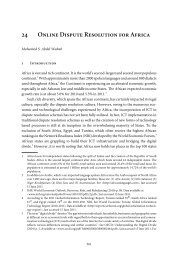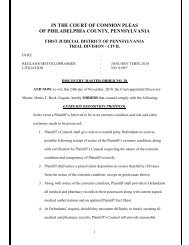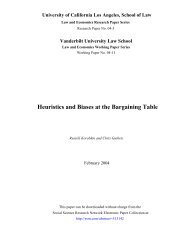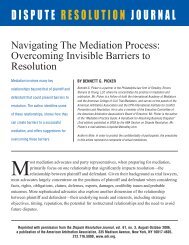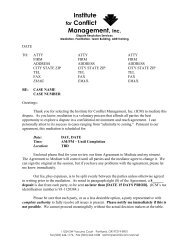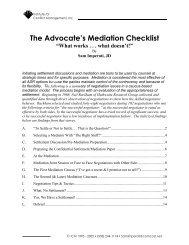17 e-Mediation - Mediate.com
17 e-Mediation - Mediate.com
17 e-Mediation - Mediate.com
Create successful ePaper yourself
Turn your PDF publications into a flip-book with our unique Google optimized e-Paper software.
Noam Ebner<br />
their use to individual practitioners. This might be done by offering “rooms” to individual<br />
mediators on an ad hoc basis or ongoing basis, much in the way a face-to-face mediation<br />
center might rent out its meeting room to an individual practitioner (e.g., The<strong>Mediation</strong>-<br />
Room, Juripax). 18 Another model involves a more robust connection between the institutional<br />
service provider and individual practitioners, in which the former sets the latter up<br />
with a dedicated “space” on their platform, branded according to the practitioner’s preferences.<br />
There have also been instances of service providers selling country-specific or language-specific<br />
licenses or concessions, and other types of partnership.<br />
3.2 Contexts of E-<strong>Mediation</strong> Application: Mediatability<br />
It is necessary to shed light on specific case elements which might make the online venue<br />
a particularly suitable arena for mediation. As for areas of particular activity, or dispute<br />
areas which seem particularly targeted by service providers, the most <strong>com</strong>mon seem to be<br />
<strong>com</strong>plaint handling, e-<strong>com</strong>merce and low-value cases between geographically distant<br />
parties. The rationale for targeting these fields in particular would seem to be inherent in<br />
the way the promise of ODR was framed by its early propounders. However, these thrusts<br />
are not as predominant as they used to be, and perhaps with good reason, given the low<br />
level of longevity among early service providers, many of whom targeted these contexts.<br />
Reviewing the websites of practitioners and service providers, it is clear that a much wider<br />
and more general net is now being cast regarding dispute type and context. Some providers<br />
do not limit customers’ imaginations to any particular context at all, and others expand<br />
on the multiple contexts in which they intervene.<br />
Two things should be kept in mind while considering the spread of e-mediation – in<br />
the past, and in the future. The first is that the use of e-mediation process has not developed<br />
in line with people’s intuitive conceptions regarding types of disputes that can be mediated<br />
online. These limiting preconceptions were breached at a very early point in e-mediation’s<br />
history, as people became accustomed to taking more and more of their lives online. The<br />
second thing to keep in mind is that many e-mediation processes take place after disputes<br />
have already entered a settlement-through-ODR process. As ODR in general casts a very<br />
wide net, different types of cases find themselves funneled through to e-mediation even<br />
though these might not have reached e-mediation as a first choice. I will expand on these<br />
two points.<br />
3.2.1 E-<strong>Mediation</strong>: Not What You Would Expect<br />
In a dynamic very reminiscent of the growth of mediation as an area of practice, it would<br />
now be difficult to isolate a dispute area in which e-mediation is not offered or would not<br />
18 See also Rule (2002).<br />
374



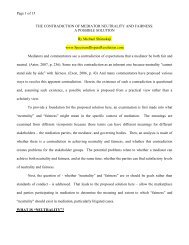

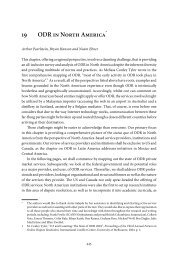
![Settlement Agreement Form [Agreement] - Mediate.com](https://img.yumpu.com/50682143/1/190x245/settlement-agreement-form-agreement-mediatecom.jpg?quality=85)

